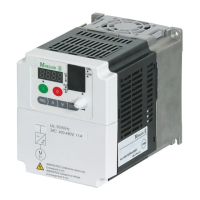09/01 AWB8230-1412GB
PID controller
91
Settings in the frequency control mode
Before you use the PID mode, you must configure the parameters
in frequency control mode. Observe the following two points:
Acceleration and deceleration ramp
The output frequency calculated by the PID algorithm is not imme-
diately available on the frequency inverter output, as the output
frequency is affected by the set acceleration and deceleration
times. Even when, for example, a large D component is defined,
the current output frequency is significantly influenced by the
acceleration and deceleration time, and this causes unstable regu-
lation.
To achieve stable behaviour in each PID closed loop control range,
the acceleration and deceleration times should be set as low as
possible.
After every acceleration and deceleration ramp parameter change,
parameters PNU A72, A73 and A74 must be rematched.
Frequency jumps/range
Frequency jumps must be defined to meet the following require-
ment: A change to the feedback actual value signal must not occur
during execution of a frequency jump. If a stable operating point
exists within a frequency jump range, operation between both end
values of this range occurs.
Configuration of setpoint value and actual value
In PID mode, you must first of all specify how the setpoint is to be
defined and where the actual value is to be supplied. The following
table provides the required settings:
It is not impossible to enter the setpoint value and the actual value
through the same analog input terminal.
Please note that the frequency inverter brakes and stops according
to the set deceleration ramp as soon as a stop command is issued
during PID operation.
Scaling
Please set the scaling to the process-corrected physical quantity as
required by your application, i.e. to flow, pressure, temperature,
etc. For a detailed description, see Section ”Scaling adjustment”,
Page 90.
Setpoint adjustment via digital inputs
The following points must be observed when setting the setpoint
via digital inputs (4 bit):
Assignment of the digital inputs
The DF5 series have five programmable digital inputs. Assign the
functions FF1 to FF4 to four of the inputs. Use PNU C01 to C05 for
this purpose, corresponding to the inputs 1 to 5 of the frequency
inverter.
Adjustment of the setpoint values
First of all, select the required number of different setpoints (up to
16) from the following table. Under PNU A21 (corresponds to the
first setpoint) to A35 (corresponds to 15th setpoint), enter the
required setpoint. PNU A20 and F01 correspond to setpoint 0.
A71 – PID control active/inactive
A72
P component of the PID controller
A73
I component of the PID controller
A74
D component of the PID controller
A75
Setpoint factor of the PID controller
A76
Input actual value signal for PID controller
PNU
Meaning of the parameters when used in
Frequency control mode PID mode
Actual value input Setpoint value definition
Integrated keypad Digital via control
terminals
(fixed frequencies)
Integrated
potentiometer
Analog voltage on
O-L
Analog current
on OI-L
Analog voltage
(O-L: 0 to 10 V)
PNU A01 = 02
PNU A76 = 01
PNU A01 = 02
PNU A76 = 01
PNU A01 = 00
PNU A76 = 01
– PNU A01 = 01
PNU A76 = 01
Analog current
(OI–L: 4 to 20 mA)
PNU A01 = 02
PNU A76 = 00
PNU A01 = 02
PNU A76 = 00
PNU A01 = 00
PNU A76 = 00
PNU A01 = 01
PNU A76 = 00
–
h
If the setpoints are to be scaled, note that the setpoints
must be entered as process-corrected quantity values in
accordance with this scaling.

